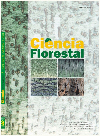
|
Ciência Florestal
Centro de Pesquisas Florestais - CEPEF, Departamento de Ciências Florestais - DCFL, Programa de Pós Graduação em Engenharia Florestal - PPGEF
ISSN: 0103-9954
EISSN: 0103-9954
Vol. 25, No. 1, 2015, pp. 91-106
|
 Bioline Code: cf15009
Bioline Code: cf15009
Full paper language: English
Document type: Research Article
Document available free of charge
|
|
|
Ciência Florestal, Vol. 25, No. 1, 2015, pp. 91-106
| pt |
ISSN 0103-9954 91 FAUNA EDÁFICA NA DINÂMICA SUCESSIONAL DA MATA ATLÂNTICA EM FLORESTA ESTACIONAL SEMIDECIDUAL NA BACIA DO RIO PARAÍBA DO SUL - RJ
Machado, Deivid Lopes; Pereira, Marcos Gervasio; Correia, Maria Elizabeth Fernandes; Diniz, Anderson Ribeiro & Menezes, Carlos Eduardo Gabriel
Resumo
A fauna edáfica, pela sua diversidade e magnitude das funções que realiza no ambiente solo, pode refletir
o estado de funcionamento dos ecossistemas. Neste sentido, este estudo teve como objetivo avaliar a
atividade, composição estrutural e diversidade da comunidade da fauna do solo, em diferentes estádios
sucessionais da Mata Atlântica, em Pinheiral - RJ. Para tanto, foram estudadas três áreas de Floresta
Estacional Semidecidual Submontana em diferentes estádios sucessionais: Floresta em Estádio Inicial (FEI),
Floresta em Estádio Médio (FEM) e Floresta em Estádio Avançado (FEA). Em cada área foi demarcada
uma parcela de 30 m x 30 m. Para captura dos organismos epígeos da mesofauna e macrofauna, utilizaramse
armadilhas do tipo “pitfall-traps”, sendo distribuídas, aleatoriamente, 10 armadilhas em cada área. Foram
realizadas amostragens em abril e agosto de 2009. A atividade dos organismos (ind arm-1 dia-1) e os índices
ecológicos de riqueza e equidade de Pielou foram calculados a partir da quantificação e identificação dos
indivíduos amostrados. A partir da análise dos resultados, contatou-se que o mês de agosto, caracterizado
com maior precipitação, influiu diretamente na atividade, composição estrutural e diversidade da fauna do
solo. A estrutura populacional foi influenciada pelos estádios sucessionais, sendo que a atividade dos grupos
Acari, Araneae, Diptera, Formicidae, Hymenoptera e Isopoda aumentou em função do avanço sucessional.
A atividade total e o índice de riqueza média também responderam ao processo de sucessão. O grupo
Entomobryomorpha foi o mais abundante em todas as áreas, sendo o responsável pelas variações do índice
de Pielou. De maneira geral, verificaram-se maiores valores da atividade dos grupos, atividade total e
riqueza média na FEA, e menores na FEI, confirmando, assim, o potencial uso desses organismos como
indicadores da dinâmica sucessional em florestas secundárias.
Palavras-chave
sucessão florestal; indicadores edáficos; fauna do solo
|
| |
| en |
SOIL FAUNA IN SUCCESSIONAL DYNAMICS OF ATLANTIC FOREST IN SEMI-DECIDUOUS SEASONAL FOREST IN THE BASIN OF RIVER ‘PARAÍBA DO SUL’, RIO DE JANEIRO STATE
Machado, Deivid Lopes; Pereira, Marcos Gervasio; Correia, Maria Elizabeth Fernandes; Diniz, Anderson Ribeiro & Menezes, Carlos Eduardo Gabriel
Abstract
The soil fauna, for its diversity and magnitude of the tasks that it carries out in the soil environment, may
reflect the state of the ecosystem functioning. Therefore, this study aimed to evaluate the activity, the structural
composition and the diversity of soil fauna community in different successional stages of Atlantic forest, in Pinheiral, RJ state. Thus, three areas of lower montane semi-deciduous forest in different succession stages
were studied: Forest in initial stage (FIS), Forest in intermediate stage (FINS) and Forest in advanced stage
(FAS). In each area, it was demarcated a plot of 30 m x 30 m. To capture the epigean organisms, mesofauna
and macrofauna, ‘pitfall-traps’ were used, being distributed, randomly, 10 traps in each area. The samples
were taken in April and August 2009. The activity of organisms (arm ind-1 day-1) and ecological index of
the richness and evenness were calculated from the quantification and identification of individuals sampled.
From the analysis of the results, it was noticed that August featured higher precipitation and directly
influenced the activity, structural composition and diversity of soil fauna. The population structure was
influenced by successional stages, and group activity Acari, Araneae, Diptera, Formicidae, Hymenoptera
and Isopoda increased with advancing succession. Total activity and average wealth index also responded
to the advancement of vegetation. The group Entomobryomorpha was the most abundant in all areas,
being responsible for the variations of the index of evenness. In general, there were higher values of group
activity, total activity and average wealth in FAS, and lower the FIS, thus confirming the potential use of
these organisms as indicators of successional dynamics of secondary forests.
Keywords
forest succession; edaphic indicators; soil fauna
|
| |
© Copyright 2015 - Ciência Florestal
Alternative site location: http://cascavel.ufsm.br/revistas/ojs-2.2.2/index.php/cienciaflorestal/index
|
|
